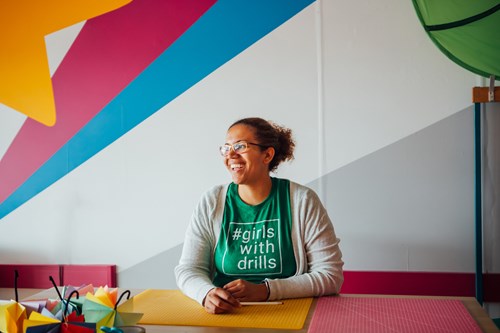Kisha Bradley, Founder of Brightbox and Girls with Drills
Sheffield makes me cry.
When I came back to visit when I’d got my visa and knew I was going to live here, I came out of the train station and I cried at the sound of the stupid fountain. Something about coming out of the station and seeing and hearing that fountain gets me all worked up. It’s like a homecoming.
My background is engineering but before that, I grew up in a rural town in the US. There were something like 768 people and two of them were non-white: me and my brother. One in every three in the community were in poverty, and my family was one of those. Another thing is that rural schools don’t have as many resources – there was no lab, no hands-on elements, no coding. The most we did with computers was learn how to type. There was nothing to prepare me to go into engineering but I didn’t know that until I was in it, looking in hindsight like, “how did I get here?!” When I was in engineering school I was questioning all these things, finding out about my community and starting to connect the dots and realise that the other students just had a lot more opportunities to be creative, to experiment and to fiddle around with everyday stuff. So that’s where I started to think about the idea for Bright Box, though it wasn’t Bright Box then – I just thought that people from deprived communities needed a way to learn hands-on problem-solving.
I lived in Germany for a year and that’s where I met my partner, who’s from Halifax and went to Sheffield Hallam. We went on holiday to London, Halifax, Sheffield and a few other places, and I fell in love with Sheffield.
I’m an engineer so I know product design, but the market research made me realise I knew nothing about children – so needing to work with kids brought me back to this idea of starting something where children can learn hands-on creative problem-solving. It wasn’t an a-ha moment, just lots of little experiences, meeting the right people at the right time and being invited to the boys’ club that happily has a lot more women in it now. Not enough, but more – and it’s those women that have lifted me up.
When I pitched at Sheffield Soup for my first funding I asked the audience to imagine a girl with a drill and Ruth Amos came up to me and was like, “we have to do something with that, #girlswithdrills”. It was just supposed to be some t-shirts to help fund the work we do in disadvantaged communities, but women started asking if they could actually have some workshops. I bought eight drills with my own money; now I have 30, and the workshops sell out a month in advance. Every time I feel like a bit of an imposter but it always goes down well.
Sheffield has so many gems, that’s why I moved here – there’s always something new to see. I like the filter coffee at Kollective Kitchen, the pies from Notty House. I live in Parson Cross and it doesn’t have the best reputation but if you live there then you know all of its little gems, and on my morning walks I see the same people and they’re so friendly – I love Sheffield’s people.
Sheffield could brag more about itself, but really, then it wouldn’t be Sheffield would it? I don’t want Sheffield to be perfect; it wouldn’t be Sheffield if it was perfect. It’s unpolished in the best way possible.
